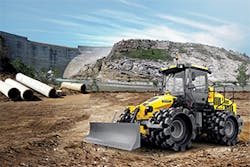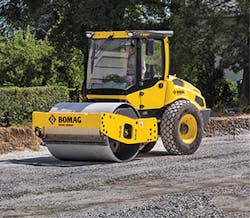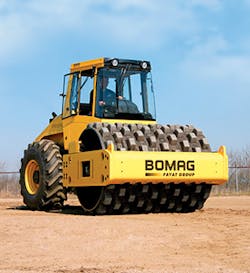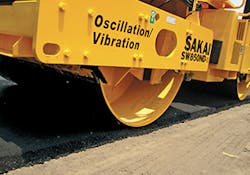Editor’s note: This article first appeared in the March/April 2016 issue of GX.
Soil compaction is the removal of air voids from soil by applied force in such a way that it conditions or compacts soil beneath or next to the construction, resulting in a denser soil with the ability to hold greater weight, points out Fred Paul, Wacker Neuson sales engineer and application manager.
Air voids are undesirable because they provide a place for water to accumulate, and also allow material to settle. Individual particles can over time re-orient and occupy the voids, says Jon Sjoblad, Caterpillar Paving Products spokesperson.
“Using the proper materials, having the proper moisture content, following the recommended lift heights, and making the required number of passes are the most important factors in achieving good compaction,” points out Vince Hunt, Wacker Neuson product application and training specialist.
“The natural ability of soil to support a structure becomes altered during excavation,” says Paul. “Its density changes and some soils become exposed. Mechanical soil compaction accelerates the natural process of the soil settling, and in some cases makes construction possible on marginal building sites.”
Soil compaction serves as preventive maintenance against settling, cracking, or heaving.
“The effects of inadequate soil preparation may take weeks or even years to become apparent,” says Paul. “However, once the results begin to show, the costs of repairs far outweigh the time and rental costs of proper soil compaction the first time around.”
Choosing the right size compactor is critical to every compaction project, points out Tim Hoffman, rollers product manager for the Atlas Copco road construction equipment division.
“Using one that’s too heavy or too light can have a huge impact on productivity and costs,” he adds. “If it doesn’t have enough force or weight to compact the material efficiently, you’ll need to make more passes to achieve the desired compaction.
“On the other hand, a roller with too much force and weight will crush the material rather than compact it, which requires replacing the material. And if a roller is too narrow for a job, it will require more passes to achieve the desired compaction. This all results in more fuel costs and more time needed to finish the job.”
There are three types of compaction equipment: static, vibratory, and impact, points out Hoffman.
Static rollers come in three-wheeled, tandem, or pneumatic-tired designs and rely on the weight of the drum and machine to compact material. They work best for compacting thin layers of soil or asphalt.
BOMAG BW177 DH-5
Vibratory rollers operate with a rapid succession of impacts to the surface, which typically achieves higher densities and reaches deeper depths than static rollers. Vibratory rollers feature one or two drums and are very effective on friction soils, but also efficiently compact cohesive soils and asphalt, he says.
Impact compaction delivers a high force to the surface. Often the rollers have triangular, rectangular, or pentagonal pads for deeper compaction. These types of rollers operate at high speeds, which is why they are ideal for large areas of soil, says Hoffman.
In making the decision as to what type of compactor to use, “the physics of compaction are unchanging,” says Frank Multerer, president of MBW.
“Your requirements are really the same. You want to match the equipment to optimize your productivity on any particular application,” he points out.
Soil type is one of the prime driving factors in choosing compaction equipment.
The fundamental factor in choosing the appropriate compactor for the job is whether the soil being compacted is native soil or soil that’s being imported in to the job site from elsewhere, says Peter Witt, president of Weber MT.
BOMAG BW 213 PDH-40
The company’s walk-behind and hand-guided equipment is targeted to small- to medium-sized jobs.
“If it’s native soil, you have to look at the conditions,” he says. “If it’s very cohesive—a very water-logged, clay-like substance—certain types of equipment are more suitable than other types of machines.
“If it’s soil being brought in—for example, at a highway on and off ramp with steep grades where you may be removing the native soil and replacing it with something being brought in from the outside—you have much more control over the type of soil and the type of equipment you can use and you’re much more effective.”
Soil is primarily classified into two main categories, says Paul: granular and cohesive.
Granular soils consist mainly of sand and gravel. The particles are coarse and large enough to see with the naked eye. When granular soil is wet, it may be molded but will crumble easily.
Granular soils are best compacted with vibration energy either with a vibratory plate or vibratory roller. The vibration action reduces the frictional forces at the contact surfaces, allowing particles to fall freely under their own weight.
As the soil particles are vibrating, they become momentarily separated from each other, allowing them to turn and twist until they can find a position that limits their movement.
For non-cohesive soils, a large reversible compactor is usually more cost-effective than a small roller might be, says Witt.
“For cohesive soil, you’d have an issue with reversible plate compactors as they tend to dig themselves in,” he adds. “This has to do with the physics of the reversible plates technology and you either use a large trench roller or impact compaction rather than vibratory compaction.”
An example of impact compaction in road building would be a small jumping jack—an upright machine that pounds the ground “so it’s brutal physical pushing rather than agitating the soil and removing water and moisture that way,” says Witt.
Cohesive soils are made up of silts and clays. The grains are very small and feel smooth when rubbed between one’s fingers. When wet, cohesive soils are sticky and can be molded or rolled into almost any shape. When dry, this soil type tends to be very hard and difficult to crumble, notes Paul.
Cohesive soils are best compacted by impact force, says Paul. “The type of machine recommended is a vibratory rammer or sheepsfoot roller,” he adds. “The impact force of the rammer or sheepsfoot roller causes a shearing effect that squeezes out air voids and excess water from between the particles.”
Mark Eckert, compaction product manager for Volvo Construction Equipment, says that for cohesive material, “you would want to choose a pad foot drum compactor or possibly a smooth drum compactor with a pad foot shell kit.”
Other factors considered in choosing compaction equipment include “layer thickness, size of the project, water content, stiffness of the underlying layer, compaction specifications, capacity requirements, and climatic conditions,” says Hoffman.
“It’s nearly impossible to achieve a high degree of compaction of soil over a low-bearing capacity soil, including soil with fine grains or high water content. For these types of soils, a vibratory roller will be the most effective,” he adds.
Dave Dennison, BOMAG product manager, adds other factors that influence equipment choice. They include:
- Compaction depth. “Contractors must remember that vibratory rollers compact the lift from the bottom up,” notes Dennison. “Therefore, the contractor must know what the lift thicknesses and fill material type will be in order to select a compactor that delivers enough vibration force to penetrate to the bottom of the lift. Otherwise, bridging can occur and the material that is not densified can lead to road failure.”
- Terrain. When building a road, compacting base and subbase on steep terrain will require a single drum roller with both drum and rear wheel drive, such as BOMAG’s smooth drum BW 177 DH-5 and padfoot drum BW 177 PDH-5 rollers, says Dennison. These rollers feature a dual-travel pump drive system with one travel pump dedicated to drum drive and the other to the rear axle. This enables the BW177DH-5/PDH-5 Series rollers to climb up to 24% higher grades than rollers with a single travel pump and parallel flow hydraulic system.
- Project area size. The larger the project size and the deeper the lift thicknesses, the larger the roller and wider the drum required on the job, says Dennison. BOMAG’s single drum rollers have drum sizes from 47.4–84 inches wide. Its double drum rollers range from 35.4–84 inches wide.
- Production goals. As with project area size, the larger the compactor, the deeper the lift thickness and the more area covered in a shorter period of time, says Dennison.
Along with the type of soil being compacted, the method of compaction used is largely determined by the job specifications that need to be met.
“Machine selection is often dictated by compaction specifications,” says Paul. “The most common specifications include lift, or soil depth/layers and the number of passes made with the machine to achieve optimum compaction.”
The selected machine should have enough power to compact the soil in the depth required, he says. “If the machine does not have enough power, the proper density will not be reached. If it has too much, over-compaction can occur. This is the result of excessive passes or too much power on too thin a soil layer.”
The number of passes depends on the situation, but to attain 95–100% Standard Proctor density, use three passes for a rammer, four for a vibratory plate, and five for a vibratory roller, notes Paul.
The actual job site is an important factor when selecting equipment, says Paul.
“In general, vibratory plates are more efficient than rollers due to the large baseplate surface area in contact with the soil,” he adds. “Vibratory plates also are more maneuverable, so they are ideal for confined areas. Rollers have the advantage in larger, open areas where there is plenty of room to maneuver.
“Because the roller has a fast travel speed, it will cover the area faster than a plate. The same logic applies to rammers, which should be used on cohesive soils in confined areas. The trench roller should be used in larger trenches and open areas.”
Smaller equipment is generally used on smaller-scale applications, such as commercial work (driveways, parking lots, small paths) and utility work (trenches and asphalt patching). Smaller equipment also is used on larger sites where there are many small tasks or the need to frequently trailer the equipment from site to site, such as compacting highway approaches, points out Sjoblad.
Typically, contractors can use walk-behind light compaction equipment, such as double drum rollers or plate compactors for small projects, including driveways or asphalt patching, notes Hoffman.
“Some are static rollers for thin layers of granular soil, while others are vibratory rollers or plate compactors that can be used on soil or asphalt,” he says. “Walk-behind rollers have narrow drums of about 25 inches, which are ideal for narrow areas such as bike paths.
“For similar projects that are longer in length, contractors also can drive compact, gas-powered asphalt rollers, such as Atlas Copco’s CC900G. The roller’s drum is 35 inches wide and has 18-inch curb clearances on the left and right sides of the machine so operators can compact close to curbs and landscaping.”
“Often you will see single direction and reversible plate compactors, like the BOMAG BVP 18/45 and BPR35/60, compacting granular and mixed soils,” says Dennison of the use of compaction equipment on small jobs. “If upgrading utilities, the articulated BOMAG BMP8500 is used for backfilling of trenches. BOMAG’s small single and double drum vibrator rollers will be used to compact base materials prior to paving the driveway.”
Rollers used on smaller jobs typically fall in the 3- to 5-ton weight class, and range from 39–54 inches in compaction width, such as rollers found in Sakai America’s SW/TW 300 Series and the SW502-1 Series, says Josh Steele, marketing manager with Sakai America.
“On some of the smallest jobs, you may even see only a small 1.5-ton roller, such as Sakai’s 36-inch CR271, or even only a walk-behind roller such as Sakai’s steerable front drum HS67ST,” he adds.
Sakai’s 58-inch, 10-ton class roller, the SW652-1, is used for small- to medium-sized jobs, notes Steele.
“Additionally, on these thin lift pavements, you also could find oscillating rollers, which make use of horizontal vibration patterns in order to effectively compact without damaging the aggregate,” says Steele. “Oscillatory rollers are also more effective on colder asphalts than typical vertical vibratory rollers.”
Sakai’s oscillation system is designed for versatility, making use of a gear-driven system with no belts to change or drums to disassemble for routine maintenance to switch back and forth from oscillation to vertical vibration on the fly. It enables the contractor to use the roller in a wide variety of applications without investing additional capital on more equipment, notes Steele.
Larger equipment is used on jobs in which scale or size counts. “This can include large site development, roads, large parking lots, and airport runways,” says Sjoblad. “The larger equipment is more efficient and can process more material than the smaller equipment in the same amount of time.”
Sakai SW850ND asphalt roller
For medium to large jobs, most contractors will use a combination of small tandem and/or small to large single drum ride-on vibratory rollers to compact the base and subbase material, says Dennison, adding the roller size and type utilized depends on such factors as project size and the contractor’s production goals.
A static tamping roller can be used for compacting cohesive soils on large projects, says Hoffman.
“Atlas Copco’s CT3000 moves as fast as 12 miles per hour, which is much faster than a vibratory soil roller,” he says. “Like other tamping rollers, the CT3000 features four padfoot drums, but the drums are mounted on rubber tires to absorb impact, designed to minimize wear on the drum and vibrations to the operator platform.”
For large soil compaction projects, a ride-on soil roller should be considered, says Hoffman.
“These weigh four to 27 tons and feature a single vibratory drum that ranges from 54 to 84 inches wide. Most soil rollers are suitable for compacting soil in relatively thick layers, but when compacting rock fill, the roller selection would be determined on depth of material and size of project,” he says. “This ensures there’s enough force for effective compaction. Soil rollers typically feature a smooth drum, but contractors also can equip them with a bolt-on padfoot shell kit for compacting cohesive soils such as silt and clay.”













